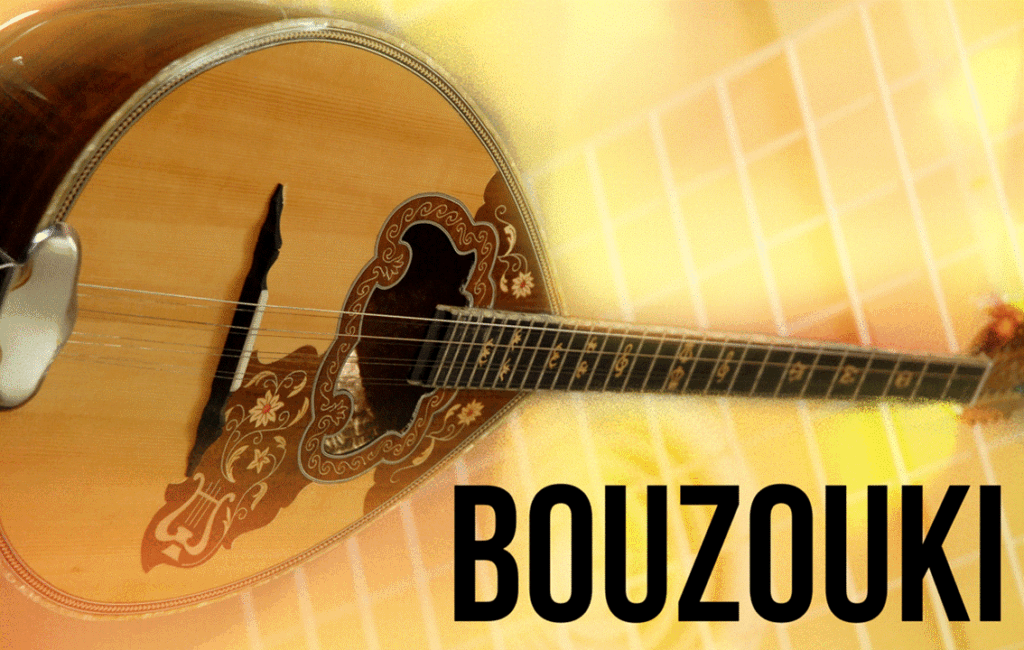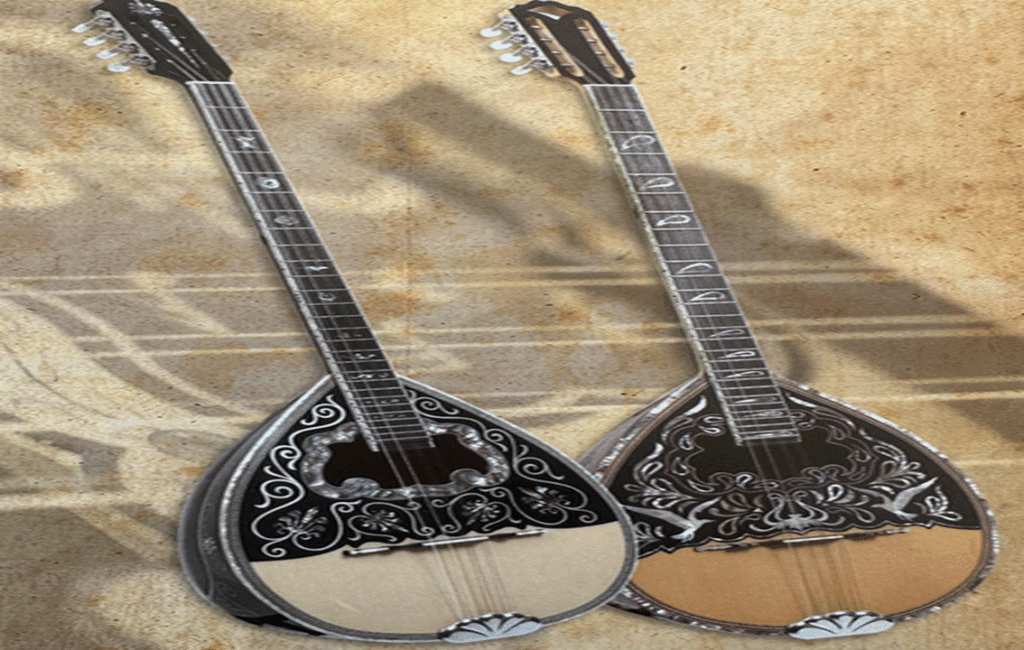
A GREEK ICON

THE BEATING HEART OF GREEK MUSIC

The Bouzouki, remians at the ‘heart’ of Greek music and the iconic stringed instrument holds a profound place in the Greek cultural and musical identity. Known for its distinctive sound, the Bouzouki is not merely an instrument but also a symbol of the Greek spirit and its rich traditions.
BOUZOUKI ORIGINS

the direct ancestor of the Bouzouki is the long-necked fretted plucked string instrument known as ‘Buzuq’. Originating in ancient Persia, this instrument evolved as it made its way west towards the Byzantine Empire, so is also closely related to both the Iranian and Turkish ‘Saz’. Today, its the Turkish ‘Saz; that most resembles the Bouzouki closely, in design and purpose. The term ‘Bouzouki’ directly derives from the Arabic word ‘Buzuq,’ and is another reference to the instrument’s origins. Elements of the Bouzouki’s roots can also be traced back to ancient Greece, where stringed instruments were prevalent in musical traditions.
BORN IN PRISON BUT RAISED IN NIGHTCLUBS

By the 19th century, the Bouzouki emerged as an essential musical instrument, making up a crusial part of urban culture of the time. This defining factor was prticularly relevant among the working classes. The instrument’s popularity also grew in Greek prisons. Crude versions of the instrument were made out of broken wooden furniture and strings from uncoiled bedsprings. Prisoners, as well as guards, would play the instrument night and day to kill time. Several inmates, after leaving prison, became full-time musicians, plying their trade in taverns, coffee shops, and nightclubs.
STRINGS ARRANGED IN COURSES

The cultural exchange and the adaptations made to the instrument in Greece has led to the Bouzouki assuming its contemporary form. Much like a ‘Saz’, the modern Bouzouki is a hand-made instrument that has a pear-shaped body, typically played with a plectrum. The original Bouzouki featured three pairs of strings arranged in courses, but later versions have adopted four pairs. This extended the instrument’s musical range and contributed further to its unique yet vibrant sound. The Bouzouki is ornately decorated mainly using mother of pearl and each design is often unique to the maker or in some cases the player.
A NATIONAL ICON

The transition from a mere folk instrument to a national icon began in the late 19th and early 20th centuries. The Bouzouki became widely recognised in the urban centres of Greece where it was embraced by the ‘Rembetiko’ musical genre. The Bouzouki became central to this musical movement and its integration allowed the Bouzouki to flourish.
THE REMBETIKO MOVEMENT

Often referred to as the ‘Greek blues’, the ‘Rembetiko’ movement expressed the struggles and life experiences of the marginalised and often impoverished classes in Greek society. This music style also strongly resonated with the general populace, effectively capturing themes of love, loss, and the harsh realities of Greek life at the time. Prominent musicians like Markos Vamvakaris and Vassilis Tsitsanis played crucial roles in popularising the Bouzouki through their performances and recordings of this music. This led to a surge in the instrument’s fame. Taverns, coffee shops and nightclubs all over Greece, became venues for live music performances featuring the Bouzouki as the main lead instrument. This attracted audiences eager to listen to and enjoy the evocative tunes of hte Rembetiko genre.
THE LAIKO MOVEMENT

The popularity of the Bouzouki continued to grow post-Second World War, with the influence of commercial recordings and radio broadcasts. This meant that the Bouzouki began to reach broader audiences and was now playing a vital role within the world of Greek popular music. This new musical genre is known as the ‘Laiko,’ movement. This new modern music form emerged in the mid-20th century and is still relevant to Greek music today. The genre is characterised by its catchy melodies and relatable lyrics.
EMBRACED INTERNATIONALLY

The instrument’s profile was also extended further when Greek music began to transcend beyond its cultural and physical borders. Greek immigrant communities, particularly the Greek diaspora mainly in the United States, Australia, the United Kingdom and Europe have kept their musical traditions alive by performing Bouzouki music at cultural festivals, weddings, and social events. This along with international recognition through film and media has meant that the Bouzouki has been embraced internationally.
A TRADITIONAL INSTRUMENT IN A MODERN WORLD

Contemporary Greek artists, such as Yiannis Parios, Giorgos Dalaras, and Glykeria, among others, have gained world recognition for their modern takes on traditional Bouzouki music. This has pushed the ‘Laiko’ movement further, helping to ensure the Bouzouki’s relevance in today’s musical landscape. The Bouzouki as a result continues not only to innovate but in some ways to dictate various music styles.
INNOVATIVE FUSIONS

In recent years the Bouzouki has continued to evolve and adapt to contemporary musical trends. Its distinctive sound has garnered interest among international musicians, who have incorporated it into several diverse musical styles. Musicians of the world over have successfully incorporated the Bouzouki into various genres, including pop, rock, classical, and ethnic world music, leading to innovative fusions, appealling to younger audiences. This has made the instrument a sought-after addition to global music collaborations the world over. All of this illustrates the Bouzouki’s versatility and its ability to resonate with people beyond Greek culture.
EMBLEMATIC OF A GREEK IDENTITY

It is important to also note that the Bouzouki is not exclusively confined to the professional musician. It has also found its way into family gatherings and social events. This has infused everyday life with popular Bouzouki music. With this, its significance has extended beyond mere musical enjoyment. When used in this way, the instrument becomes intertwined with the social and cultural fabric of Greek life. The Bouzouki is emblematic of a Greek identity that represents Greek history and Greek values.
A GREEK LEGACY

The Bouzouki stands as a testament to a rich musical heritage. From its origins, rooted in ancient stringed instruments, to its modern adaptation, it has become an integral part of the Greek identity. Serving as a representation of the Greek spirit, the instrument’s historical trajectory exemplifies the resilience and adaptability of Greek culture as a whole. Illuminating its significance, in the context of a Greek lifestyle, the Bouzouki remains a beloved national instrument. Playing a vital role in defining the Greek cultural landscape, the Bouzouki often embodies both the struggle and joy of the Greek people. Acting as a cultural bridge between past and present, the instrument also evokes a sense of nostalgia and longing. As the Bouzouki continues to influence and inspire world music today, its sweet, yet vibrant melodies, resonate in the hearts of both Greeks and those who appreciate the beauty of its music worldwide.



